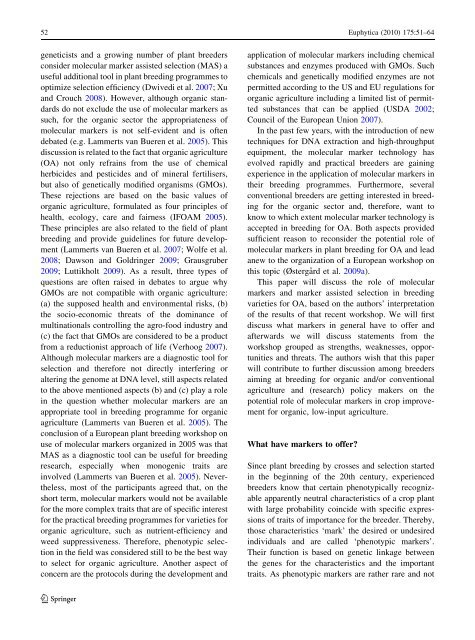The role of molecular markers and marker assisted selection in ...
The role of molecular markers and marker assisted selection in ...
The role of molecular markers and marker assisted selection in ...
You also want an ePaper? Increase the reach of your titles
YUMPU automatically turns print PDFs into web optimized ePapers that Google loves.
52 Euphytica (2010) 175:51–64<br />
geneticists <strong>and</strong> a grow<strong>in</strong>g number <strong>of</strong> plant breeders<br />
consider <strong>molecular</strong> <strong>marker</strong> <strong>assisted</strong> <strong>selection</strong> (MAS) a<br />
useful additional tool <strong>in</strong> plant breed<strong>in</strong>g programmes to<br />
optimize <strong>selection</strong> efficiency (Dwivedi et al. 2007;Xu<br />
<strong>and</strong> Crouch 2008). However, although organic st<strong>and</strong>ards<br />
do not exclude the use <strong>of</strong> <strong>molecular</strong> <strong><strong>marker</strong>s</strong> as<br />
such, for the organic sector the appropriateness <strong>of</strong><br />
<strong>molecular</strong> <strong><strong>marker</strong>s</strong> is not self-evident <strong>and</strong> is <strong>of</strong>ten<br />
debated (e.g. Lammerts van Bueren et al. 2005). This<br />
discussion is related to the fact that organic agriculture<br />
(OA) not only refra<strong>in</strong>s from the use <strong>of</strong> chemical<br />
herbicides <strong>and</strong> pesticides <strong>and</strong> <strong>of</strong> m<strong>in</strong>eral fertilisers,<br />
but also <strong>of</strong> genetically modified organisms (GMOs).<br />
<strong>The</strong>se rejections are based on the basic values <strong>of</strong><br />
organic agriculture, formulated as four pr<strong>in</strong>ciples <strong>of</strong><br />
health, ecology, care <strong>and</strong> fairness (IFOAM 2005).<br />
<strong>The</strong>se pr<strong>in</strong>ciples are also related to the field <strong>of</strong> plant<br />
breed<strong>in</strong>g <strong>and</strong> provide guidel<strong>in</strong>es for future development<br />
(Lammerts van Bueren et al. 2007; Wolfe et al.<br />
2008; Dawson <strong>and</strong> Goldr<strong>in</strong>ger 2009; Grausgruber<br />
2009; Luttikholt 2009). As a result, three types <strong>of</strong><br />
questions are <strong>of</strong>ten raised <strong>in</strong> debates to argue why<br />
GMOs are not compatible with organic agriculture:<br />
(a) the supposed health <strong>and</strong> environmental risks, (b)<br />
the socio-economic threats <strong>of</strong> the dom<strong>in</strong>ance <strong>of</strong><br />
mult<strong>in</strong>ationals controll<strong>in</strong>g the agro-food <strong>in</strong>dustry <strong>and</strong><br />
(c) the fact that GMOs are considered to be a product<br />
from a reductionist approach <strong>of</strong> life (Verhoog 2007).<br />
Although <strong>molecular</strong> <strong><strong>marker</strong>s</strong> are a diagnostic tool for<br />
<strong>selection</strong> <strong>and</strong> therefore not directly <strong>in</strong>terfer<strong>in</strong>g or<br />
alter<strong>in</strong>g the genome at DNA level, still aspects related<br />
to the above mentioned aspects (b) <strong>and</strong> (c) play a <strong>role</strong><br />
<strong>in</strong> the question whether <strong>molecular</strong> <strong><strong>marker</strong>s</strong> are an<br />
appropriate tool <strong>in</strong> breed<strong>in</strong>g programme for organic<br />
agriculture (Lammerts van Bueren et al. 2005). <strong>The</strong><br />
conclusion <strong>of</strong> a European plant breed<strong>in</strong>g workshop on<br />
use <strong>of</strong> <strong>molecular</strong> <strong><strong>marker</strong>s</strong> organized <strong>in</strong> 2005 was that<br />
MAS as a diagnostic tool can be useful for breed<strong>in</strong>g<br />
research, especially when monogenic traits are<br />
<strong>in</strong>volved (Lammerts van Bueren et al. 2005). Nevertheless,<br />
most <strong>of</strong> the participants agreed that, on the<br />
short term, <strong>molecular</strong> <strong><strong>marker</strong>s</strong> would not be available<br />
for the more complex traits that are <strong>of</strong> specific <strong>in</strong>terest<br />
for the practical breed<strong>in</strong>g programmes for varieties for<br />
organic agriculture, such as nutrient-efficiency <strong>and</strong><br />
weed suppressiveness. <strong>The</strong>refore, phenotypic <strong>selection</strong><br />
<strong>in</strong> the field was considered still to be the best way<br />
to select for organic agriculture. Another aspect <strong>of</strong><br />
concern are the protocols dur<strong>in</strong>g the development <strong>and</strong><br />
application <strong>of</strong> <strong>molecular</strong> <strong><strong>marker</strong>s</strong> <strong>in</strong>clud<strong>in</strong>g chemical<br />
substances <strong>and</strong> enzymes produced with GMOs. Such<br />
chemicals <strong>and</strong> genetically modified enzymes are not<br />
permitted accord<strong>in</strong>g to the US <strong>and</strong> EU regulations for<br />
organic agriculture <strong>in</strong>clud<strong>in</strong>g a limited list <strong>of</strong> permitted<br />
substances that can be applied (USDA 2002;<br />
Council <strong>of</strong> the European Union 2007).<br />
In the past few years, with the <strong>in</strong>troduction <strong>of</strong> new<br />
techniques for DNA extraction <strong>and</strong> high-throughput<br />
equipment, the <strong>molecular</strong> <strong>marker</strong> technology has<br />
evolved rapidly <strong>and</strong> practical breeders are ga<strong>in</strong><strong>in</strong>g<br />
experience <strong>in</strong> the application <strong>of</strong> <strong>molecular</strong> <strong><strong>marker</strong>s</strong> <strong>in</strong><br />
their breed<strong>in</strong>g programmes. Furthermore, several<br />
conventional breeders are gett<strong>in</strong>g <strong>in</strong>terested <strong>in</strong> breed<strong>in</strong>g<br />
for the organic sector <strong>and</strong>, therefore, want to<br />
know to which extent <strong>molecular</strong> <strong>marker</strong> technology is<br />
accepted <strong>in</strong> breed<strong>in</strong>g for OA. Both aspects provided<br />
sufficient reason to reconsider the potential <strong>role</strong> <strong>of</strong><br />
<strong>molecular</strong> <strong><strong>marker</strong>s</strong> <strong>in</strong> plant breed<strong>in</strong>g for OA <strong>and</strong> lead<br />
anew to the organization <strong>of</strong> a European workshop on<br />
this topic (Østergård et al. 2009a).<br />
This paper will discuss the <strong>role</strong> <strong>of</strong> <strong>molecular</strong><br />
<strong><strong>marker</strong>s</strong> <strong>and</strong> <strong>marker</strong> <strong>assisted</strong> <strong>selection</strong> <strong>in</strong> breed<strong>in</strong>g<br />
varieties for OA, based on the authors’ <strong>in</strong>terpretation<br />
<strong>of</strong> the results <strong>of</strong> that recent workshop. We will first<br />
discuss what <strong><strong>marker</strong>s</strong> <strong>in</strong> general have to <strong>of</strong>fer <strong>and</strong><br />
afterwards we will discuss statements from the<br />
workshop grouped as strengths, weaknesses, opportunities<br />
<strong>and</strong> threats. <strong>The</strong> authors wish that this paper<br />
will contribute to further discussion among breeders<br />
aim<strong>in</strong>g at breed<strong>in</strong>g for organic <strong>and</strong>/or conventional<br />
agriculture <strong>and</strong> (research) policy makers on the<br />
potential <strong>role</strong> <strong>of</strong> <strong>molecular</strong> <strong><strong>marker</strong>s</strong> <strong>in</strong> crop improvement<br />
for organic, low-<strong>in</strong>put agriculture.<br />
What have <strong><strong>marker</strong>s</strong> to <strong>of</strong>fer<br />
S<strong>in</strong>ce plant breed<strong>in</strong>g by crosses <strong>and</strong> <strong>selection</strong> started<br />
<strong>in</strong> the beg<strong>in</strong>n<strong>in</strong>g <strong>of</strong> the 20th century, experienced<br />
breeders know that certa<strong>in</strong> phenotypically recognizable<br />
apparently neutral characteristics <strong>of</strong> a crop plant<br />
with large probability co<strong>in</strong>cide with specific expressions<br />
<strong>of</strong> traits <strong>of</strong> importance for the breeder. <strong>The</strong>reby,<br />
those characteristics ‘mark’ the desired or undesired<br />
<strong>in</strong>dividuals <strong>and</strong> are called ‘phenotypic <strong><strong>marker</strong>s</strong>’.<br />
<strong>The</strong>ir function is based on genetic l<strong>in</strong>kage between<br />
the genes for the characteristics <strong>and</strong> the important<br />
traits. As phenotypic <strong><strong>marker</strong>s</strong> are rather rare <strong>and</strong> not<br />
123

















